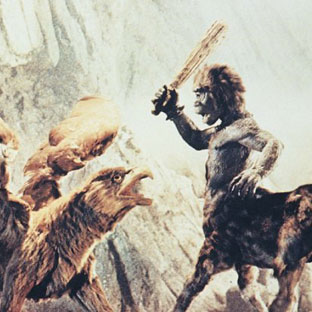
In 1974, my friend Kenny Ames and I went to a theater and saw “The Golden Voyage of Sinbad.” Two Now ‘N Later-chomping seven-year-olds, we weren’t there to see the performances of the human actors (John Phillip Law, Tom Baker, and Caroline Munro). We were there to be awed by the onslaught of fantastic creatures: an evil wizard’s flying reptilian spy; a giant six-armed statue of Kali coming to life; the climactic battle between a griffin and a cyclopean centaur. We rushed home and made drawings of them on paper plates while the memories of their hideous screeches and menacing, writhing forms were still fresh.
I soon realized that my favorite movies on TV – “The 7th Voyage of Sinbad,” (1958) “Mysterious Island” (1961), and “Jason and the Argonauts” (1963), had something in common besides the awesome monsters: they had special visual effects created by Ray Harryhausen. Harryhausen, who passed away May 7th at age 92, is revered by fantasy film geeks, special effects artists, and directors alike for his masterful advancement of the stop motion animation technique.
Stop motion animation is a visual effect achieved by taking stills of three-dimensional articulated models that are painstakingly moved a fraction of an inch between shots. When the resulting film is run, the effect of independent motion is created. Each model must be photographed 24 times for each second of screen time. Now imagine applying this technique to animating a seven-headed hydra, or a squadron of sword-wielding skeletons. Working alone, Harryhausen methodically filmed scenes in a day or two, sequences in a month or two, and enough sequences for a full-length film in a year or two.
Harryhausen was a behind-the-scenes “technician” and “craftsman” who contributed directly to the thematic content of the movie. His hand was responsible for every aspect of the fantasy sequences he created, from the conceptual drawings and sculptures of models, up through cinematography and post-production effects. As director John Landis (“An American Werewolf in London”) observed in a 1995 interview, Harryhausen was “truly an auteur” of the work.
Harryhausen’s technique was called “Dynamation”. It involved new, complex methods of montage that combined rear-projection photography and traveling mattes to create the effect of human characters interacting with fantasy beasts against a real background.
Harryhausen’s first major special effects movie was 1949’s giant gorilla epic, “Mighty Joe Young.” On that film, Harryhausen worked with his stop-motion mentor, Willis O’Brian, who provided the groundbreaking effects for “King Kong” (1933). Harryhausen next provided a rampaging Rhedosaurus for “The Beast From 20,000 Fathoms” (1953). In the sixties and seventies, Harryhausen created his most famous work exploring Greek and Arabic myths: “Jason” and the “Sinbad” movies, culminating in 1981’s “Clash of the Titans.”
Harryhausen’s creations are memorable are memorable not only for their technical brilliance, but also for the emotional “performances” of the creatures – he imbued them with a sympathetic expressiveness that enabled them to be read as “real” characters we care about. In a 1995 interview, Harryhausen said he had an early, passing interest in acting, and cited an acting class he took at L.A. City College as the foundation for the drama he brought to life in his creatures.
Harryhausen was always drawn to the popular imagery of myths and prehistory. Never “faithful” to his sources, he freely mixed and matched mythos, combining extinct creatures with gods and monsters from a variety of traditions, and a heaping portion of poetic license. It didn’t matter that Harryhausen’s bizarre mytho-poetic mash-ups ignored the cultural, historical and geographical specifics of the myths from which they borrowed. Who cared if the Kraken is from Norse, not Greek mythology, or that a giant horned caveman co-exists in Sinbad’s time? What really mattered was that we finally had an answer to the question, “who would survive a death-cage match between a dragon and a giant, cloven-hoofed Cyclops?”
Idolized by generations of filmmakers and special effects artists, Harryhausen was recognized for his contributions to cinema with a Lifetime Achievement Academy Award in 1992, presented by his good friend, fellow fantasy icon Ray Bradbury. Contemporary fantasy directors such as Steven Spielberg (“Jurassic Park”) Sam Raimi (Evil Dead, Spider-Man), Peter Jackson (“Lord of the Rings,” “King Kong”) and Tim Burton (“Beetlejuice,” “Pee-Wee’s Big Adventure”) all hail Harryhausen as an early major influence.
In a 1997 interview, Harryhausen said, “fantasy is essentially a dream world… and I don’t think that you want it quite real, you want it to be an interpretation – stop motion to me gives it that added value as a dream world that you can’t catch if you try to make it too real.” Of computer generated imagery (CGI) he said: “If you make things too real, sometimes you bring it down to the mundane.”
Photo: “The Golden Voyage of Sinbad,” Columbia Pictures
Links:
Ray Harryhausen
http://www.imdb.com/name/nm0366063/?ref_=sr_1
Sinbad Battles Kali
http://www.youtube.com/watch?v=hohUHIndLg0
Jason Battles Skeletons
http://www.youtube.com/watch?v=pF_Fi7x93PY
This is Dynamation!
http://www.youtube.com/watch?v=arq6fTGkC6E
Taro vs. Cyclops










